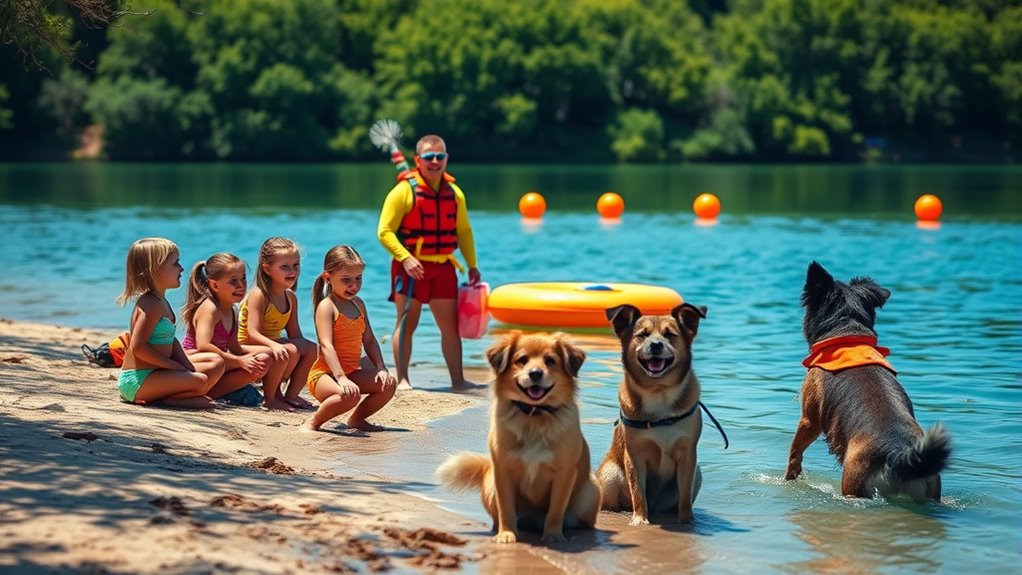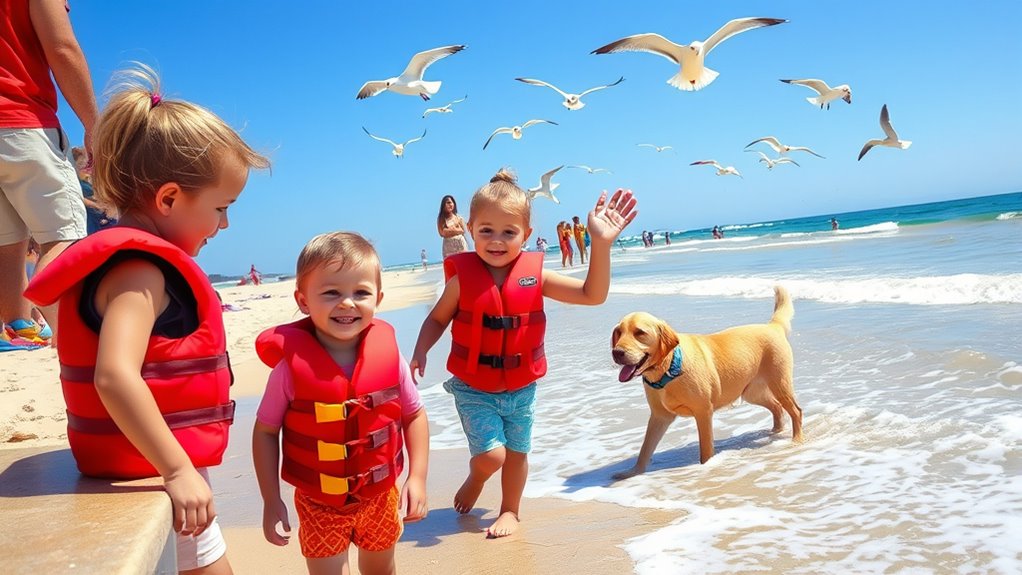When sharing the shoreline with kids and dogs, always supervise closely and establish clear safety rules. Keep children within designated swimming areas, teach them how to recognize hazards, and make certain they stay away from deep or rough waters. Use life jackets for dogs and watch for signs of distress. Quickly respond to emergencies with effective rescue techniques. Continuing your efforts helps everyone stay safe and enjoy the water responsibly—there’s more to explore for better safety tips.
Key Takeaways
- Always supervise children and dogs near water to prevent accidents and ensure quick response if needed.
- Designate safe, hazard-free swimming zones for both kids and dogs to minimize risks.
- Teach children water safety rules, including staying within designated areas and avoiding dangerous spots.
- Use life jackets for dogs and teach kids rescue techniques like reaching or throwing flotation devices.
- Educate family members on emergency response and water rescue procedures for both children and pets.

Spending time near the water can be fun for both kids and dogs, but safety should always come first. You want everyone to enjoy the day without worry, and that means being prepared for potential emergencies like a dog rescue or accidents related to swimming safety. Dogs are naturally curious and may not recognize their limits when it comes to water, so keeping a close eye on your furry friend is essential. Always supervise them, especially in unfamiliar environments, and consider using a dog life jacket if they aren’t strong swimmers. This way, if your dog gets tired or unexpectedly slips into deeper water, you can act quickly to prevent a dangerous situation.
Understanding the importance of swimming safety helps protect your dog from accidents. Never assume your pet can handle deep water just because they seem comfortable on land. Keep a designated safe zone where your dog can swim freely, and ensure the area is free of hazards like sharp rocks or strong currents. If your dog shows signs of distress or fatigue, it’s vital to intervene promptly. Recognize the signs of trouble—such as frantic paddling, barking, or trying to climb out—and be ready to perform a dog rescue if needed. Having a plan in place and knowing how to safely pull your dog out of the water can make all the difference in an emergency. Additionally, water safety education can help you and your family stay prepared for any water-related situation.
For kids, water safety is equally important. Teach them to respect the water and follow safety rules, like never swimming alone or venturing into deep water without supervision. Make sure children understand that they should stay within designated swimming areas and avoid dangerous spots like boat ramps or areas with strong currents. Encourage them to keep a close eye on their canine friends, especially near the shoreline, so no one gets unexpectedly pulled into the water or ends up in a risky situation. You can also teach kids basic rescue techniques, like reaching with a stick or throwing a flotation device, rather than jumping into the water themselves.
Frequently Asked Questions
How Can I Teach My Dog to Swim Safely?
To teach your dog to swim safely, start in shallow water and use positive reinforcement to build confidence. Keep sessions short and stay close to your dog, always supervising. Use a dog life vest for extra safety during dog swimming, and avoid rough play or deep water until your dog is comfortable. Remember, practicing water safety guarantees your furry friend enjoys swimming while staying safe.
What Should I Do if My Child or Dog Gets Swept Away?
What’s your first move if your child or dog gets swept away? Stay calm and act quickly by calling for help and implementing water safety tips like reaching with a pole or throwing a flotation device instead of jumping in. Your emergency response should focus on keeping yourself safe while trying to assist. Always keep a close eye on kids and dogs near water and practice these safety measures regularly to prevent accidents.
Are There Specific Life Jackets Recommended for Dogs?
Yes, there are specific dog flotation devices and canine life jackets designed for safety. Look for options with adjustable straps, a secure fit, and a handle for easy rescue. Choose a life jacket rated for your dog’s size and activity level, ensuring it provides enough buoyancy. Always test the fit before heading into the water, and supervise your dog closely to prevent accidents. Proper gear keeps your furry friend safe and confident around water.
How Can I Identify Dangerous Water Conditions Quickly?
When it comes to spotting dangerous water conditions, you’ve got to keep your eyes peeled. Look out for strong water currents, which can pull you or your dog under, and check the water temperature—cold water can cause hypothermia quickly. Watch for choppy waves, murky water, or sudden changes in water behavior. Trust your instincts; if something feels off, it’s better to stay safe and steer clear.
What Are Signs of Water Distress in Children and Dogs?
You can spot water distress in children and dogs by observing signs like frantic splashing, thrashing, or sudden quietness. Look for difficulty breathing, excessive panicking, or fatigue. Staying alert to these signs heightens your water safety awareness and helps prevent injuries. Remember, injury prevention tips include close supervision, keeping children and pets within arm’s reach, and knowing how to perform rescue techniques. Acting quickly can save lives and ensure everyone stays safe.
Conclusion
By following these water safety rules, you create a safe haven where kids and dogs can enjoy the shoreline together, like a well-tuned symphony. Remember, staying vigilant and respecting the water’s power keeps everyone protected. So, always supervise, use life jackets, and keep a watchful eye—because the shoreline is best enjoyed when everyone’s safe and sound. With these habits, you’ll turn your beach outings into worry-free adventures for all.










